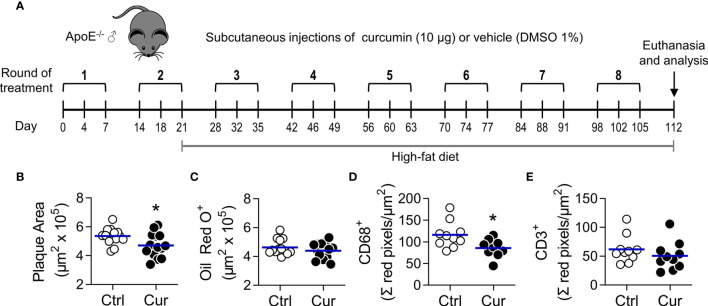Figure 1.
Subcutaneous microdose delivery of curcumin attenuates atherosclerosis development in dyslipidemic ApoE-/- mice. (A) ApoE-/- mice were treated three times a week (1 round of treatment), with subcutaneous injections of curcumin (Cur, 10 µg) or vehicle (Ctrl, DMSO 1%) for 8 rounds every other week, and fed a high-fat diet (HFD), as shown. Animal euthanasia was performed on day 112, and samples were collected and processed as indicated in Materials and Methods. (B, C) Cryosections from the aortic root were stained with (B) H&E and (C) Oil red O, to quantify plaque area and lipid deposition, respectively. (D, E) The extent of (D) macrophage (CD68+) and (E) T cell (CD3+) infiltration in aortic root cryosections was also assessed by immunofluorescent staining. The areas of the atheromatous lesions, lipid deposition, as well as the macrophage and T cell infiltrates were calculated with an image analysis software (see Materials and Methods). Each point represents the average area per mouse (7-9 sections/mouse), and bars represent the mean of 10-15 mice. *P<0.05 (Mann-Whitney U test). In repetition experiments, similar reductions in the atheromatous plaque area were observed ( Supplementary Figure S1 ).

